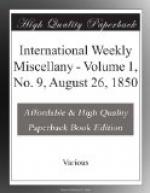In the second class, containing the works of the middle ages, and showing the uninterrupted progress of the numismatic art down to modern times, and forming alone fourteen volumes, we find the source which the French artists and men of letters have studied with such predilection. First in order are the Italian medals of the fifteenth and sixteenth centuries, chiefly by the famous Victor Pisano, a Veronese, whom Nasari has so much lauded. The scholars and imitators of Pisano also produced works as interesting as historical documents as they are admirable in workmanship. Here also will be found the French and English seals, in which the balance of skill in design and execution is acknowledged to be in our favor.
Less barbarous, and indeed perfect works of art, in character of costume and visage, are the medals struck in Germany during the sixteenth and seventeenth centuries, when the influence of Albert Durer and his school was strongly felt. And finally, relics of ornamental art of different nations and epochs.
In the third class, two parts only are devoted to contemporary art; the medals illustrative of the French revolution of 1789; those of the “Empire” and of the Emperor “Napoleon;” generally smacking of the florid and corrupt taste of that period, they are nevertheless curious as being often the sole evidence of the facts commemorated. There is, however, a manifest improvement in the late ones, and in them may be traced the transition from the independent ideas of the revolution to the subsequent submission to one man: and not less striking is the transition from a slip-shod style of art to a pedantic imitation of the antique. The “Tresor de Numismatique et de Glyptique” is the most scientific and important work of art which has been executed and achieved of late years in France. Our great public libraries may be proud of possessing so rich, so valuable, and so curious a collection,
Most lovers of art have their favorite periods and well-beloved masters, but in this varied range of excellence it is difficult which to select for preference and admiration. The cameos have a beauty and finesse which far surpass that of busts and statues; they evince the skill of grouping, which, with rare exceptions, such as the Niobe and Laocoon, is seldom aimed at in the more important pieces of sculpture. Cameos, moreover, let us, as it were, into the secrets of indoor life. To these considerations we may add that these gems have had an immense influence on French modern art. The “Apotheosis of Augustus” especially, known to antiquarians as the “Agate of Tiberius,” the largest cameo in the world, and beautifully engraved the size of the original in this collection, may be traced in more than one of their late compositions.
It is said that large medallions are a sign of taste either in the medalist or the monarch he is supposed to honor; if so, Dupre and Varin have drawn a thick vail over the effulgence of Louis XIV. We would not, however, lose their wigs and smiles for a world of historiettes.




